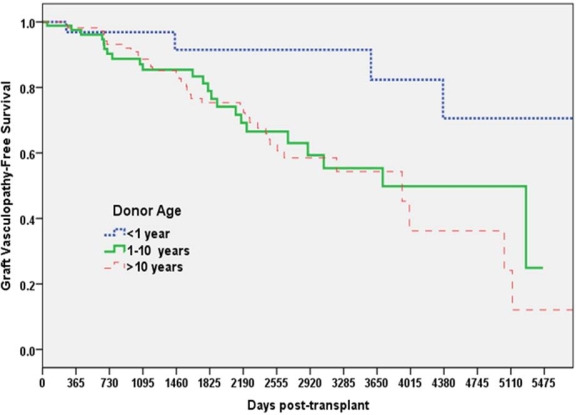Donor Age and Late Rejection Are Associated With the Development of Graft Coronary Artery Vasculopathy in Pediatric Heart Transplant Recipients
Division of Pediatric Cardiology, Columbia University Medical Center, New York, NY.
Meeting: 2015 American Transplant Congress
Abstract number: C174
Keywords: Heart transplant patients, Pediatric
Session Information
Session Name: Poster Session C: "Loss of Breath": VADs and Other Pre-Heart Transplant Matters
Session Type: Poster Session
Date: Monday, May 4, 2015
Session Time: 5:30pm-6:30pm
 Presentation Time: 5:30pm-6:30pm
Presentation Time: 5:30pm-6:30pm
Location: Exhibit Hall E
Purpose: Graft coronary artery vasculopathy (GCV) is one of the major causes of morbidity and mortality in pediatric heart transplant (HT) recipients, and in fact is the leading cause of re-HT in these patients. We seek to evaluate one of the largest single center pediatric HT cohorts for associations with the development of GCV.
Methods: Data for 338 pediatric HT recipients transplanted at our institution between 2/1993-8/2013 were reviewed. Fourteen patients that did not survive post-HT > 7 days and 21 patients who have not yet undergone coronary evaluation were excluded. Recipient demographics and pre-HT, operative and post-HT data were reviewed, as well as donor characteristics. The primary outcome of freedom from GCV was analyzed using Cox modeling to adjust for recipient and donor factors. Factors with p-value ≤ 0.1 were considered for inclusion in the final multivariate model. Kaplan-Meier (KM) survival analysis for freedom from GCV based on donor age was performed.
Results: There was development of GCV in 81 of 303 patients evaluated. Median time to development of GCV amongst these patients was 3.5 years (range 0.14-20.0 years). In a multivariate model adjusting for recipient age, donor age (donor age 1-10 years vs. < 1 year HR 3.2, CI 1.1-9.6, p=0.04; donor age > 10 years vs. <1 year HR 4.2, CI 1.1-16.0, p=0.04) and presence of late rejection > 12 months post-HT (HR 1.9, CI 1.1-3.1, p=0.02) were predictors of freedom from GCV. Factors such as immunosuppressive choices including use of induction therapy, use of steroids at discharge and at 1 year post-HT, and choice of calcineurin inhibitor and antimetabolite were not predictors of freedom from GCV; nor were EBV or CMV status of the recipient, positive crossmatch at time of HT, ABO-incompatible HT, or early rejection. KM survival analysis demonstrated a significant difference in freedom from GCV based on donor age.
Conclusions: We demonstrate that when controlling for recipient age, donor age and the presence of late rejection are predictors of freedom from GCV in pediatric HT recipients.
To cite this abstract in AMA style:
Zuckerman W, Richmond M, Lee T, Addonizio L. Donor Age and Late Rejection Are Associated With the Development of Graft Coronary Artery Vasculopathy in Pediatric Heart Transplant Recipients [abstract]. Am J Transplant. 2015; 15 (suppl 3). https://atcmeetingabstracts.com/abstract/donor-age-and-late-rejection-are-associated-with-the-development-of-graft-coronary-artery-vasculopathy-in-pediatric-heart-transplant-recipients/. Accessed January 8, 2026.« Back to 2015 American Transplant Congress
